fuel pressure JEEP WRANGLER 2009 Owners Manual
[x] Cancel search | Manufacturer: JEEP, Model Year: 2009, Model line: WRANGLER, Model: JEEP WRANGLER 2009Pages: 502, PDF Size: 13.82 MB
Page 78 of 502
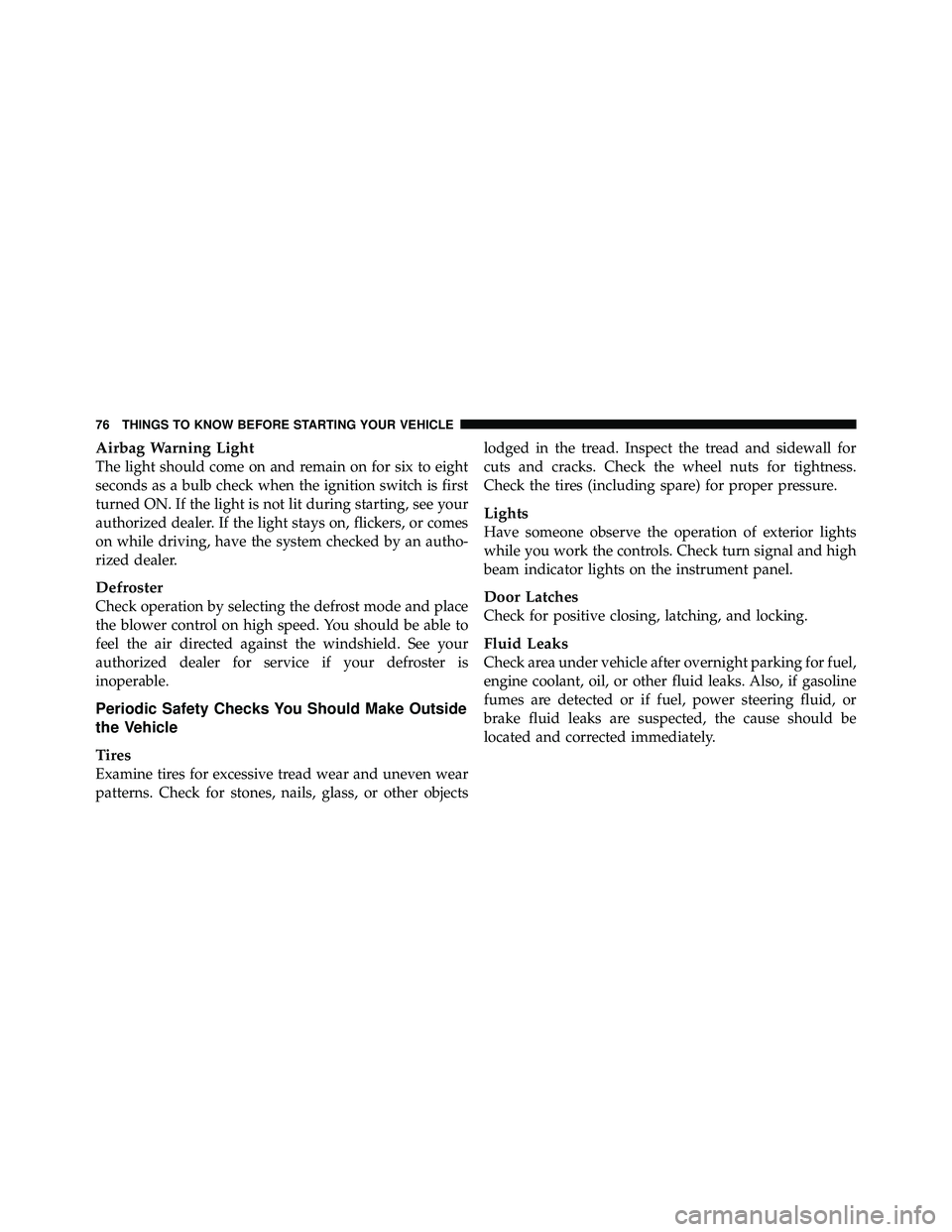
Airbag Warning Light
The light should come on and remain on for six to eight
seconds as a bulb check when the ignition switch is first
turned ON. If the light is not lit during starting, see your
authorized dealer. If the light stays on, flickers, or comes
on while driving, have the system checked by an autho-
rized dealer.
Defroster
Check operation by selecting the defrost mode and place
the blower control on high speed. You should be able to
feel the air directed against the windshield. See your
authorized dealer for service if your defroster is
inoperable.
Periodic Safety Checks You Should Make Outside
the Vehicle
Tires
Examine tires for excessive tread wear and uneven wear
patterns. Check for stones, nails, glass, or other objectslodged in the tread. Inspect the tread and sidewall for
cuts and cracks. Check the wheel nuts for tightness.
Check the tires (including spare) for proper pressure.
Lights
Have someone observe the operation of exterior lights
while you work the controls. Check turn signal and high
beam indicator lights on the instrument panel.
Door Latches
Check for positive closing, latching, and locking.
Fluid Leaks
Check area under vehicle after overnight parking for fuel,
engine coolant, oil, or other fluid leaks. Also, if gasoline
fumes are detected or if fuel, power steering fluid, or
brake fluid leaks are suspected, the cause should be
located and corrected immediately.
76 THINGS TO KNOW BEFORE STARTING YOUR VEHICLE
Page 202 of 502
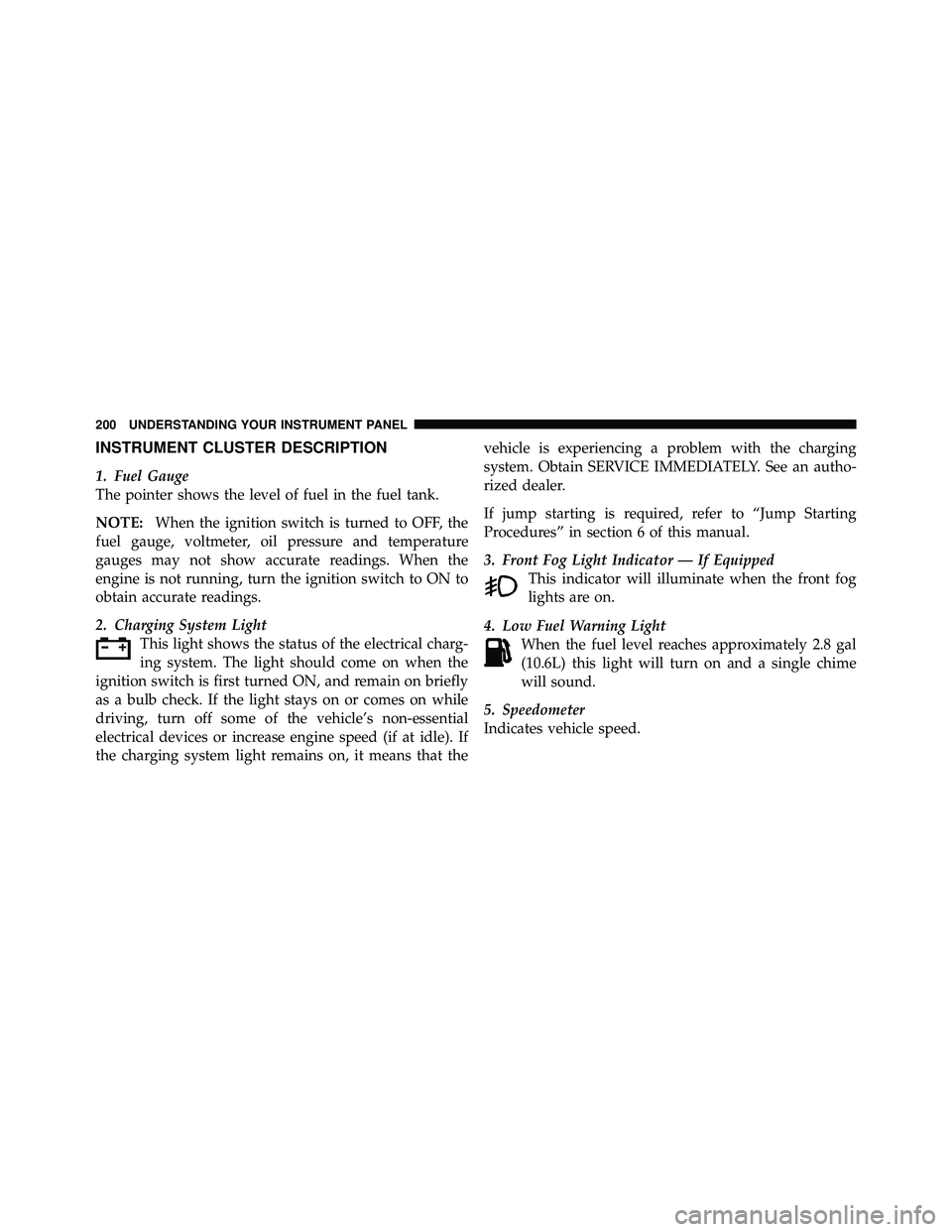
INSTRUMENT CLUSTER DESCRIPTION
1. Fuel Gauge
The pointer shows the level of fuel in the fuel tank.
NOTE:When the ignition switch is turned to OFF, the
fuel gauge, voltmeter, oil pressure and temperature
gauges may not show accurate readings. When the
engine is not running, turn the ignition switch to ON to
obtain accurate readings.
2. Charging System Light This light shows the status of the electrical charg-
ing system. The light should come on when the
ignition switch is first turned ON, and remain on briefly
as a bulb check. If the light stays on or comes on while
driving, turn off some of the vehicle’s non-essential
electrical devices or increase engine speed (if at idle). If
the charging system light remains on, it means that the vehicle is experiencing a problem with the charging
system. Obtain SERVICE IMMEDIATELY. See an autho-
rized dealer.
If jump starting is required, refer to “Jump Starting
Procedures” in section 6 of this manual.
3. Front Fog Light Indicator — If Equipped
This indicator will illuminate when the front fog
lights are on.
4. Low Fuel Warning Light When the fuel level reaches approximately 2.8 gal
(10.6L) this light will turn on and a single chime
will sound.
5. Speedometer
Indicates vehicle speed.
Page 208 of 502
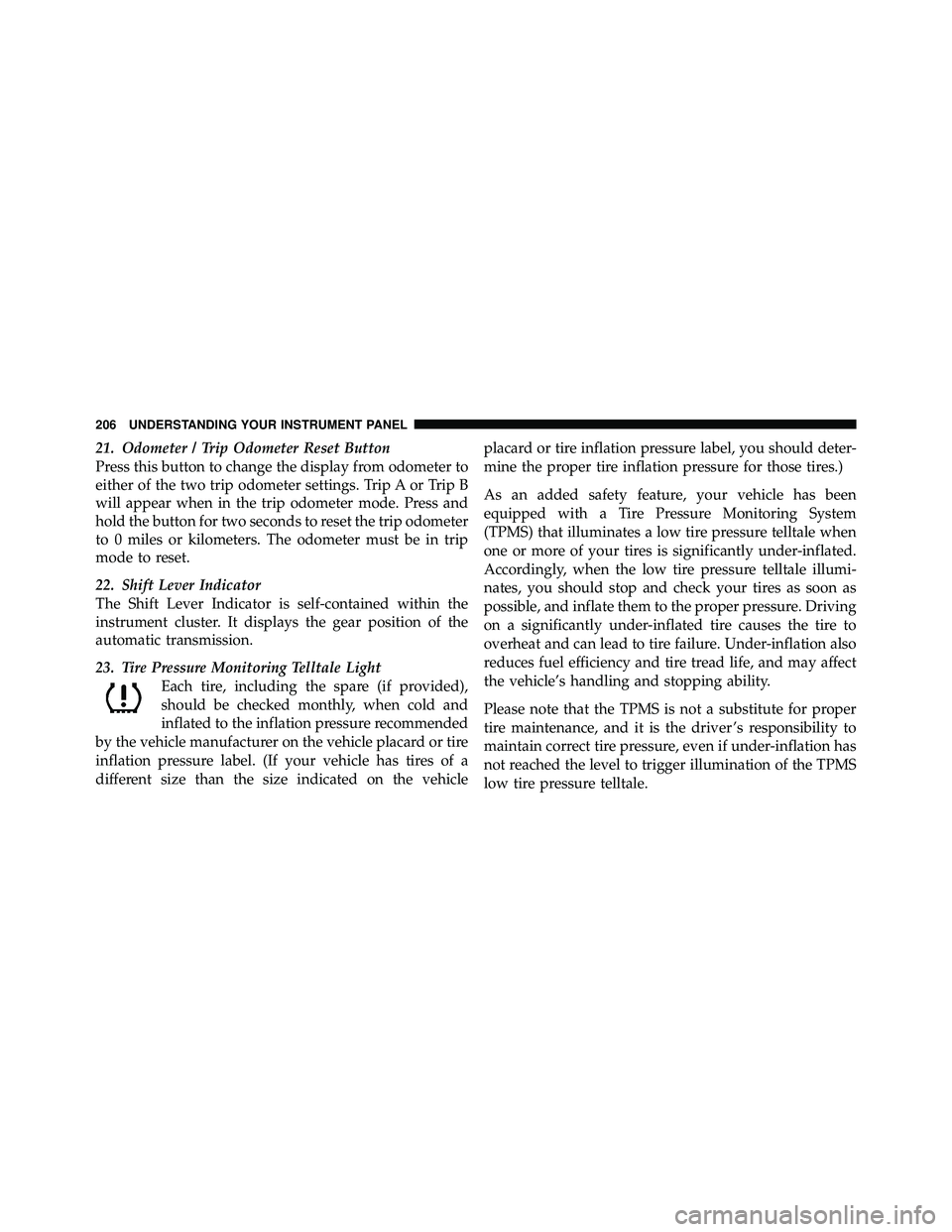
21. Odometer / Trip Odometer Reset Button
Press this button to change the display from odometer to
either of the two trip odometer settings. Trip A or Trip B
will appear when in the trip odometer mode. Press and
hold the button for two seconds to reset the trip odometer
to 0 miles or kilometers. The odometer must be in trip
mode to reset.
22. Shift Lever Indicator
The Shift Lever Indicator is self-contained within the
instrument cluster. It displays the gear position of the
automatic transmission.
23. Tire Pressure Monitoring Telltale LightEach tire, including the spare (if provided),
should be checked monthly, when cold and
inflated to the inflation pressure recommended
by the vehicle manufacturer on the vehicle placard or tire
inflation pressure label. (If your vehicle has tires of a
different size than the size indicated on the vehicle placard or tire inflation pressure label, you should deter-
mine the proper tire inflation pressure for those tires.)
As an added safety feature, your vehicle has been
equipped with a Tire Pressure Monitoring System
(TPMS) that illuminates a low tire pressure telltale when
one or more of your tires is significantly under-inflated.
Accordingly, when the low tire pressure telltale illumi-
nates, you should stop and check your tires as soon as
possible, and inflate them to the proper pressure. Driving
on a significantly under-inflated tire causes the tire to
overheat and can lead to tire failure. Under-inflation also
reduces fuel efficiency and tire tread life, and may affect
the vehicle’s handling and stopping ability.
Please note that the TPMS is not a substitute for proper
tire maintenance, and it is the driver ’s responsibility to
maintain correct tire pressure, even if under-inflation has
not reached the level to trigger illumination of the TPMS
low tire pressure telltale.
Page 358 of 502

vehicle in place of the spare tire, the TPMS will update
automatically and the “Tire Pressure Monitoring Tell-
tale Light” will turn OFF, as long as no tire pressure is
below the low-pressure warning limit in any of the
four active road tires. The vehicle may need to be
driven for up to 20 minutes above 15 mph (25 km/h)
in order for the TPMS to receive this information.
General Information
This device complies with part 15 of the FCC rules and
RSS 210 of Industry Canada. Operation is subject to the
following conditions:
•This device may not cause harmful interference.
•This device must accept any interference received,
including interference that may cause undesired
operation.The tire pressure sensors are covered under one of the
following licenses:
United States
..................... KR5S120123
Canada ........................ 2671-S120123
FUEL REQUIREMENTS
All engines are designed to meet all emis-
sions regulations and provide excellent
fuel economy and performance when us-
ing high quality unleaded “regular” gaso-
line having an octane rating of 87. The use
of premium gasoline is not recommended,
as it will not provide any benefit over regular gasoline in
these engines.
Light spark knock at low engine speeds is not harmful to
your engine. However, continued heavy spark knock at
high speeds can cause damage, and immediate service is
required.
Page 366 of 502
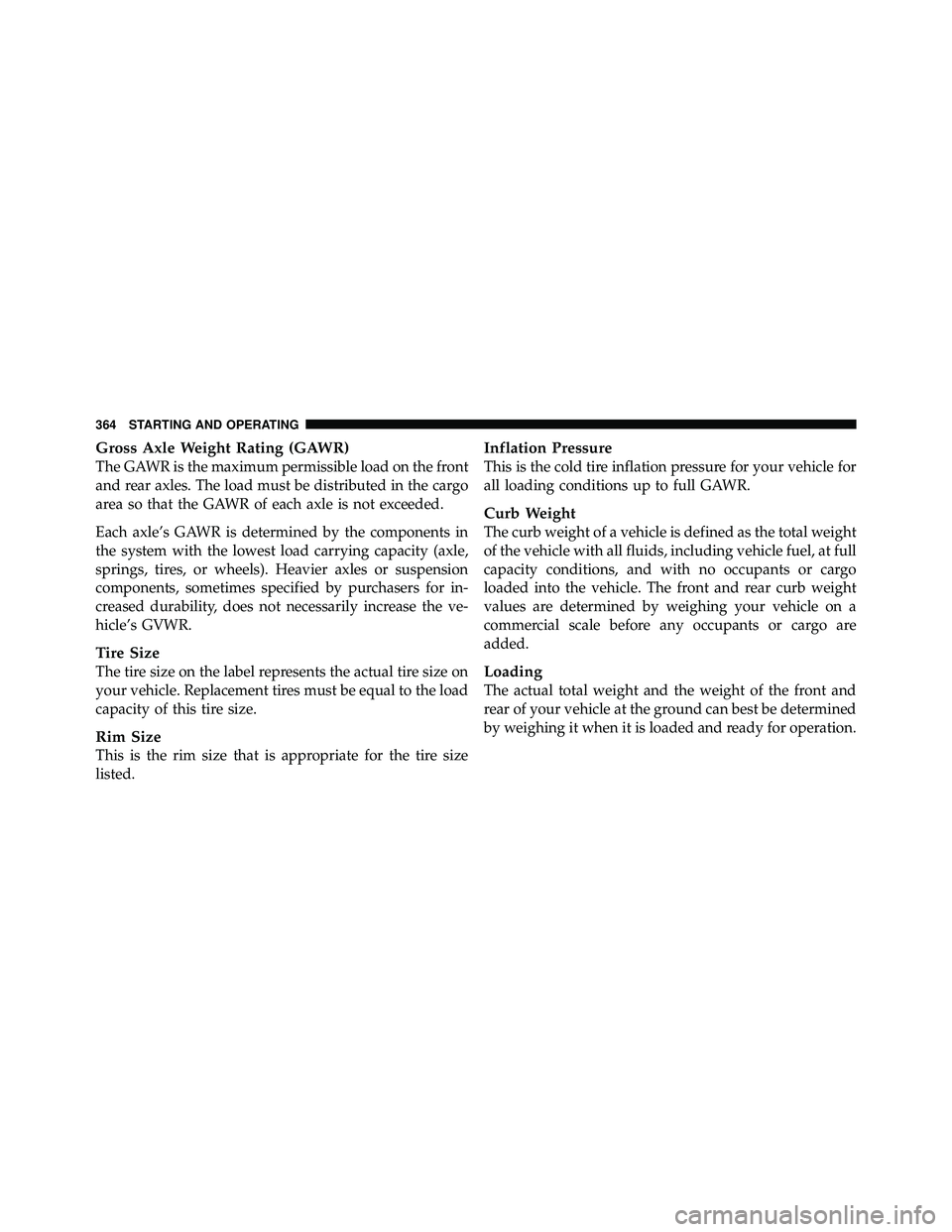
Gross Axle Weight Rating (GAWR)
The GAWR is the maximum permissible load on the front
and rear axles. The load must be distributed in the cargo
area so that the GAWR of each axle is not exceeded.
Each axle’s GAWR is determined by the components in
the system with the lowest load carrying capacity (axle,
springs, tires, or wheels). Heavier axles or suspension
components, sometimes specified by purchasers for in-
creased durability, does not necessarily increase the ve-
hicle’s GVWR.
Tire Size
The tire size on the label represents the actual tire size on
your vehicle. Replacement tires must be equal to the load
capacity of this tire size.
Rim Size
This is the rim size that is appropriate for the tire size
listed.
Inflation Pressure
This is the cold tire inflation pressure for your vehicle for
all loading conditions up to full GAWR.
Curb Weight
The curb weight of a vehicle is defined as the total weight
of the vehicle with all fluids, including vehicle fuel, at full
capacity conditions, and with no occupants or cargo
loaded into the vehicle. The front and rear curb weight
values are determined by weighing your vehicle on a
commercial scale before any occupants or cargo are
added.
Loading
The actual total weight and the weight of the front and
rear of your vehicle at the ground can best be determined
by weighing it when it is loaded and ready for operation.
364 STARTING AND OPERATING
Page 484 of 502

ABS (Anti-Lock Brake System)............203,316
Adding Fuel ........................... 361
Air Cleaner, Engine (Engine Air Cleaner Filter) . . . 409
Air Conditioner Maintenance ............... 410
Air Conditioning ..................... 266,269
Air Conditioning Controls ................. 269
Air Conditioning, Operating Tips ............ 270
Air Conditioning Refrigerant ................ 411
Air Conditioning System .................. 269
Air Filter .............................. 409
Air Pressure, Tires ....................... 343
Airbag ................................ 48
Airbag Deployment ....................... 56
Airbag Light ....................... 58,76,204
Airbag Maintenance ....................... 58
Airbag, Side ............................ 55
Alarm Light ........................... 204
Alarm (Security Alarm) .................... 17
Alterations/Modifications, Vehicle ............. 8Antenna, Satellite Radio
................... 259
Antifreeze (Engine Coolant) ................ 447
Anti-Lock Brake System (ABS) ............316,319
Anti-Lock Warning Light .................. 203
Appearance Care ........................ 428
Arming Theft System (Security Alarm) ......... 18
Auto Down Power Windows ................ 36
Automatic Transmission ................... 423
Fluid and Filter Changes ................. 423
Fluid Level Check ..................... 424
Fluid Type ........................... 423
Gear Ranges ......................... 288
Shifting ............................. 287
Special Additives ...................... 425
Torque Converter ...................... 291
Auxiliary Electrical Outlet (Power Outlet) ...... 106
Auxiliary Power Outlet ................... 106
Axle Lock .......................... 296,297
482 INDEX
Page 492 of 502
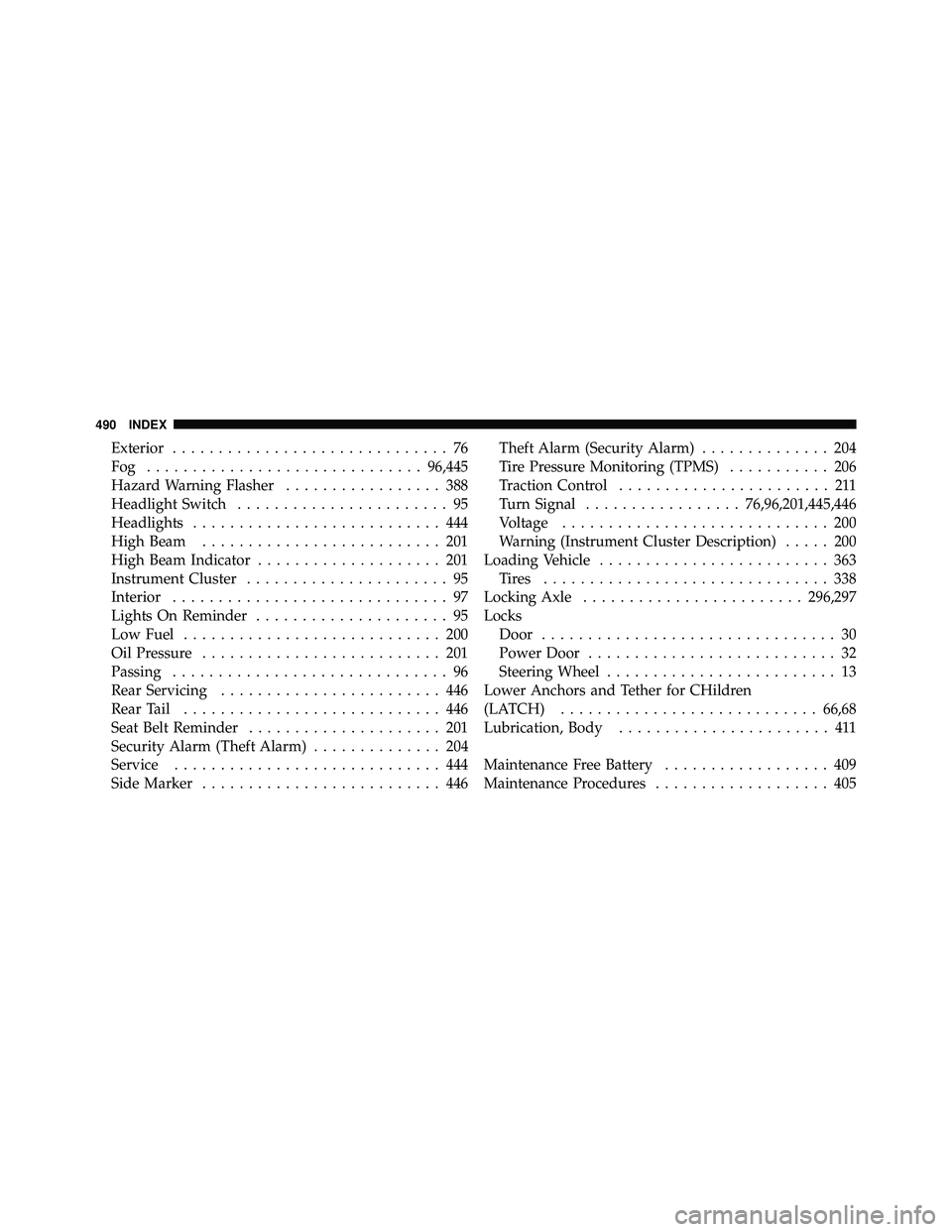
Exterior.............................. 76
Fog .............................. 96,445
Hazard Warning Flasher ................. 388
Headlight Switch ....................... 95
Headlights ........................... 444
High Beam .......................... 201
High Beam Indicator .................... 201
Instrument Cluster ...................... 95
Interior .............................. 97
Lights On Reminder ..................... 95
Low Fuel ............................ 200
Oil Pressure .......................... 201
Passing .............................. 96
Rear Servicing ........................ 446
Rear Tail ............................ 446
Seat Belt Reminder ..................... 201
Security Alarm (Theft Alarm) .............. 204
Service ............................. 444
Side Marker .......................... 446 Theft Alarm (Security Alarm)
.............. 204
Tire Pressure Monitoring (TPMS) ........... 206
Traction Control ....................... 211
Turn Signal ................. 76,96,201,445,446
Voltage ............................. 200
Warning (Instrument Cluster Description) ..... 200
Loading Vehicle ......................... 363
Tires ............................... 338
Locking Axle ........................ 296,297
Locks Door ................................ 30
Power Door ........................... 32
Steering Wheel ......................... 13
Lower Anchors and Tether for CHildren
(LATCH) ............................ 66,68
Lubrication, Body ....................... 411
Maintenance Free Battery .................. 409
Maintenance Procedures ................... 405
490 INDEX